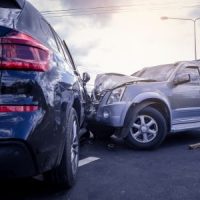Recovery for T-Bone Accident Injuries

It’s hard to predict what type of injury a person will sustain in a car accident, as the brutal impact of collisions can cause everything from broken bones and lacerations to head trauma and organ failure. It is also true, however, that certain types of accidents are more likely to cause specific injuries. Read on to learn more about the kinds of injuries often sustained in t-bone collisions.
Defining T-Bone Accidents
T-bone crashes are named for the shape that the vehicles make upon colliding, as the front end of one vehicle strikes the driver’s or passenger’s side of another at a 90 degree angle (creating a T-shape). These kinds of accidents typically occur in intersections, as it is common for multiple vehicles to be traveling in various directions at these locations. T-bone collisions also often occur at high speeds, with one vehicle speeding through an intersection in an effort to beat a red light.
Determining Liability for a T-Bone Accident
It’s not always possible to determine liability for a t-bone crash based purely on the positions of the vehicles. Sometimes it is the driver of the vehicle that struck the other car broadside who is at fault, while in others, the driver of the vehicle that was struck is to blame. Determining fault will require a wide range of evidence, including eyewitness statements, video footage from security, cell phone, and dashboard cameras, and photographs from the accident scene. After conducting a thorough investigation, it is often discovered that a t-bone accident was the result of one driver’s failure to abide by Florida’s right-of-way laws. In some situations, both drivers may bear some responsibility for the crash.
T-Bone Accident Injuries
The kinds of injuries sustained in a t-bone crash typically depend on whether the injured party was in the striking vehicle or in the vehicle that was struck. In the former, vehicle occupants are more likely to suffer from:
- Concussions caused by blunt force trauma to the head;
- Facial injuries, such as burns, fractures, and bruising, from airbag deployment;
- Clavicle fractures; and
- Internal injuries.
Occupants of the vehicle that was struck in a t-bone crash, on the other hand, while also susceptible to injury, are more likely to suffer from:
- Hearing loss from striking their head on the window;
- Whiplash caused by the sudden movement of the head and neck from side to side; and
- Fractured shoulders, ribs, and hips from striking the door upon impact.
Of course, being in one or the other vehicle doesn’t guarantee that a person won’t suffer a certain type of injury. Head trauma, for instance, is common in all types of crashes, as is bruising, lacerations, and soft tissue injuries.
Contact Our Tampa Car Accident Lawyers Today
T-bone accidents can and do cause serious injuries every day in Florida. If you were injured in such a collision and have questions about your own legal options following the crash, please call Anderson & Anderson at 813-251-0072 and set up a meeting with one of our experienced Tampa T-bone crash lawyers. As what you might call a big small law firm, our attorneys and large support staff have the ability to meet all of your legal needs, while still giving your case the personalized attention it deserves.
Sources:
flhsmv.gov/pdf/crashreports/crash_facts_2022.pdf
leg.state.fl.us/Statutes/index.cfm?App_mode=Display_Statute&URL=0300-0399/0316/Sections/0316.121.html
